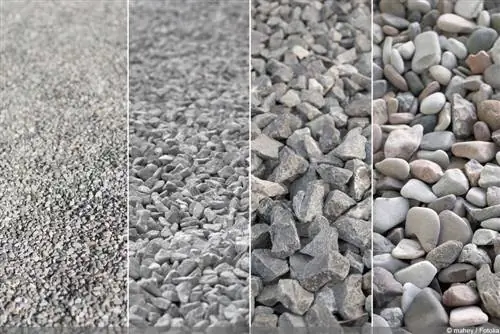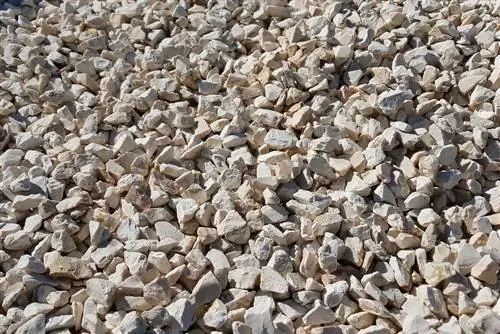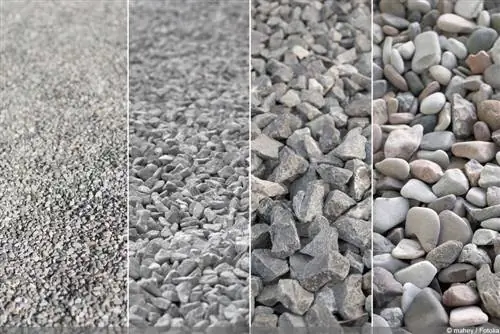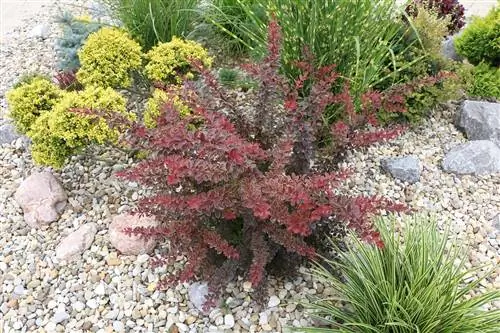- Author admin [email protected].
- Public 2023-12-17 03:39.
- Last modified 2025-01-24 12:45.
Drainage gravel is often used as a splash guard on paths. Because it is cheap, easy to apply and is a simple way to protect house walls and keep the basement dry. However, when selecting the type of gravel and the grain size, there are a few factors to consider. Interested DIY enthusiasts can find out what it is here.
Function and properties
The function of drainage gravel is to allow water to seep away as evenly as possible. The gravel also gives the water time to be absorbed into the ground - while also serving as a spike protection. The gravel layer serves, on the one hand, for drainage and the drainage of water and, on the other hand, to protect house walls.
Therefore, it can also be used as a so-called ring drainage, for example. A gravel ring is placed around the house, which allows water to drain away better and, for example, prevents moisture and liquid from penetrating into the basement or house walls.
Washed or unwashed?
Drainage gravel is offered washed and unwashed. If possible, the washed version should be chosen because it will not become muddy when it comes into contact with water and can therefore drain the liquid away better.
Grain sizes and soil type
The drainage gravel is available in different grain sizes. Available commercially include:
- 0 to 2 millimeters
- 2 to 8 millimeters
- 8 to 16 millimeters
- 16 to 32 millimeters
Mixtures of grain sizes are also possible, with 8 to 32 or 8/32 millimeters being common. These differences in size are not only noticeable in the purchase price. The grain size also has an influence on the infiltration behavior and should therefore be selected to suit the respective soil type. In general, the heavier and denser the soil, the larger the gravel grain size should be. For a loamy or clayey soil, 16 to 32 or 8 to 32 millimeters should be chosen. Smaller grain sizes are sufficient for loose, sandy soils.
Frost-resistant
Not every store offers types of gravel that are specifically designed for drainage. When selecting, however, care should be taken to ensure that the type of gravel corresponds to the required grain size and is frost-resistant. This does not automatically apply to all gravel variants. If you are unsure, you should ask specifically before purchasing. Typically suitable varieties include:
- River gravel
- Empty gravel
- Antifreeze gravel
Price comparison

The prices for the drainage gravel are given either by volume or by weight. Between 30 and 40 euros have to be taken into account for one cubic meter. For 25 kilograms the costs can range between 3 and 9 euros. Due to the sometimes very different costs, prices should be compared before purchasing, as there is great savings potential here. When comparing prices, pay attention to the following points:
- is the bulk material washed or unwashed
- volume or weight are specified
- what grain size is it
The costs are only directly comparable if the products are variants with the same properties. The prices should also be compared with the costs of delivery or transport. Depending on the retailer, these can also vary greatly.
Selection and application
It doesn't take much effort to select and create gravel paths. The only points that need to be taken into account are:
- Select gravel grain size to match the soil. A coarse grain size should be chosen for heavy soils. For more absorbent, loose soils, the grain size may be smaller.
- Washed types of gravel do not tend to become muddy and drain water better. If unwashed gravel is chosen, it should be rinsed thoroughly before spreading. It should be noted that water consumption can be very high, especially on longer and wider paths. It is therefore usually more cost-effective to choose directly washed gravel.
- To ensure that the bulk goods stay on the path, a barrier should be installed. Lawn edging stones are an option. Alternatively, a depression can also be created. The edges should be slightly compacted so that the water cannot escape to the side.
- The bulk material is spread in the designated area and distributed evenly with a rake. However, it should not be compacted as this can impair the drainage function.






